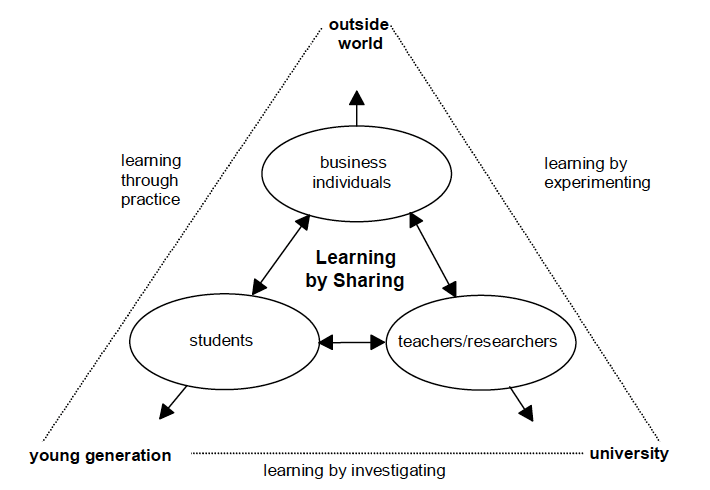A student challenge has been developed as a teaching methodology for the class “Entrepreneurial and Cross Cultural Competences” in the third semester of International Management and for the incoming undergraduate business students of the Global Business Program at FH JOANNEUM. Aim of the class is to teach “Intercultural and Entrepreneurial Mindset” to the students.
Competences of managers and business professionals need to be growingly flexible and varied to tackle the challenges of the modern business environment. Traditional ways of teaching business students, focusing mostly on building knowledge and providing skills to solve well-defined problems are not sufficient. There is a growing need for more flexibility in the growingly informal learning process. (Abcouwer, Smit and Takács, 2016). As a result, the educational landscape needs to change. (European University Association, 2008; Ernst & Young, 2015). New teaching methods are emerging, putting students into a more active role, allowing them to design their learning pathways independently.
But how can that be achieved?
To provide a new up to date leaning experience, we have adapted the Learning by Sharing model (Thijssen & Gijselaers, 2006), which includes three learning styles: learning through practice, learning by experimenting and learning by investigating. All involved parties should learn from the shared experience. Communities of practice (Lave and Wenger, 1991) are formed and opportunities of reflection are created.

Teachers, researchers, students and practitioners join forces to establish learning communities. Its main improvements on existing learning models are the systematic introduction of the external world into the learning process and the reciprocal nature of the interactions involved.
What was done?
As proposed by the learning by sharing model from Thijssen & Gijselaers (2006) we directly involved entrepreneurs from our partner companies, who provided real live cases, for which they were looking for solutions. Teaching staff at FH JOANNEUM acted as coaches and moderators for the whole event providing the third group of teachers/researchers as proposed by the model. The cases provided were screened by the involved teaching staff and adapted to the level of competence the students had already acquired in order to provide a challenge but no unsolvable problems.
The challenge was set-up in a two-week period. At the first day of the week teams of five to six students (mixing incoming and regular students) have been formed and the cases have been introduced to students. A copy of the case (~4 pages of information) was provided on the project platform, together with suggested links and documents to start research on the involved issues. Introduction of the cases was done directly by the entrepreneurs, which developed the cases, introducing the persons behind the question to the students from the very beginning. Students had one week time to get acquainted to the cases and preparing for group work. The second week of the challenge was the working week. The student teams worked on their assigned cases independently. Each of the cases had several well defined questions, it was the choice of the students if they wanted to try to answer all of the questions or specialize on the solution for one specific item. On each of the four working days, a half-hour consulting session with one of the supporting teaching staff was mandatory for all the teams and all the team members. The students were free to choose the professor (and the respective field) they wanted to have consulting in. On the second day of the working week, a Q&A session with the case providers was arranged, in person or per skype, to allow the students to ask any questions they had while working on the respective solutions. The student’s tasks included to produce an elevator pitch – a summary of their findings and suggestions, which could be presented in no more than two minutes – and a presentation for 15 minutes. At the final event the students finally presented their elevator pitches. A jury consisting of experts from the case-providers and the university selected the best two pitches for every provided case, the selected groups presented their presentations and for each of the cases a winner was selected. All finished presentations were completed with detailed comments, uploaded to the platform and of course provided to the case providers.
What happened?
The students have provided excellent answers to the proposed real-world cases, several of which have been realized by the entrepreneurs. Solutions to the cases have shown a large variety of answers, with completely different elements being in the focus in different groups. Grading of the course was mostly based on the final products, consisting of the elevator pitch and the commented presentations. The average level of performance has been high (with 89% of points achieved in average), clearly showing that the amount of work invested in this self-paced, student centred approach was in no way less than in a lecturer led class-room environment.
The case-providers were positively surprised by the quality of the feedback they received and some have already announced interest to participate again, several follow up activities have evolved between the involved entrepreneurs, teaching staff and some of the student teams. Clearly demonstrating that communities of practice have actually evolved.
Student feedback was generally positive and constructive, pointing out a few useful adaptations, which will for sure be considered in future editions of the challenge. The student-challenge, which has been started as a prototype will be included in the syllabi of the university in is currently foreseen to be repeated every year.
It is important for students to learn to understand, that there are different ways to approach answers and that completely different answers can be correct solutions to real world problems. The old class-room paradigm of analysing a problem and finding the one correct solution might be outdated for many fields. The current student population, being digital natives excels in using provided nodes for their own learning success and are quick to enlarge their own educational networks.
References
Abcouwer, T., Smit, B., & Takács, E. (2016). De-linearizing learning. Proceedings of the Special Interest Group for Education.
European University Association. (2008). European universities' charter on lifelong learning. EUA.
Ernst & Young. (2015). The University of the Future: A thousand year old industry on the cusp of pro-found change. Retrieved from http://www.ey.com/
Thijssen, J. P., & Gijselaers, W. (2006). Dynamics in Business and its Consequences for Learning Business. PrimaVera working papers. Amsterdam: Department of Information Management.
Lave, J., & Wenger, E. (1991). Situated learning: Legitimate peripheral participation. Cambridge university press.
THIS BLOG ENTRY IS BASED ON:
Beinhauer R., Jovanovski B. (2019). A connectivist view on student challenges to teach cross-cultural competences and an entrepreneurial mind-set. Presented at the Cross-Cultural Business Conference 2019, May 16th-17th, 2019. University of Applied Sciences Upper Austria; Steyr.









